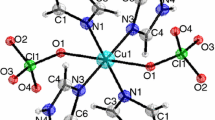Abstract
Magnetic moment measurements and ultra-violet diffuse reflectance spectroscopy have been used to investigate the structure of the chloroacetates of copper(II). These studies indicate that cupric monochloroacetate dihydrate is dimeric and cupric trichloracetate tetrahydrate is monomeric. Cupric dichloracetate tetrahydrate forms an intermediate case. The thermal decomposition of these compounds under nitrogen has been studied using thermogravimetry and differential thermal analysis, together with analysis of the products of the decomposition. The major organic product formed in the thermal decomposition of the mono- and dichloracetates is the corresponding chlorinated acetic acid; the solid inorganic product is cuprous chloride. Thermal decomposition of the trichloracetate yields cupric chloride and a mixture of trichloracetic acid and trichloracetyl chloride.
Résumé
La mesure du moment magnétique et la spectroscopie de réflexion diffuse dans l'U. V. sont utilisées pour étudier la structure des chloroacétates de cuivre (II). Les résultats indiquent que le monochloroacétate de cuivre (II) dihydraté est dimère et que le trichloroacétate de cuivre (II) tétrahydraté est monomère. Le dichloroacétate de cuivre (II) tétrahydraté représente un cas intermédiaire. La décomposition de ces composés dans l'azote a été suivie par thermogravimétrie et analyse thermique différentielle, en analysant simultanément les produits de décomposition. Le principal produit organique formé lors de la décomposition thermique des mono et dichloroacétates est l'acide chloroacétique correspondant; le produit solide inorganique est le chlorure de cuivre (I). La décomposition thermique du trichloroacétate fournit le chlorure de cuivre (II) et un mélange d'acide trichloracétique et de chlorure trichloroacétylique.
Zusammenfassung
Messungen des magnetischen Momentes sowie diffuse UV-Remissionspektroskopie wurden zur Untersuchung der Struktur der Kupfer(II)-chloracetate eingesetzt. Die Ergebnisse deuten darauf hin, daß Kupfermonochloracetat-Dihydrat dimer und Kupfertrichloracetat-Tetrahydrat monomer ist. Das Kupferdichloracetat-Tetrahydrat bildet hierbei eine Zwischenstufe. Die thermische Zersetzung dieser Verbindungen wurde in Stickstoffatmosphäre unter Anwendung der Thermogravimetrie und Differentialthermoanalyse untersucht, bei gleichzeitiger Analyse der Zersetzungsprodukte. Das bei der thermischen Zersetzung des Mono- und Dichloracetats gebildete organische Hauptprodukt ist die entsprechende chlorierte Essigsäure; der feste anorganische Rückstands das Kupfer(I)-chlorid. Die thermische Zersetzung des Trichloracetats ergibt Kupfer(II)-chlorid sowie eine Mischung von Trichloressigsäure und Trichloracetylchlorid.
Резюме
Измерения магнитных моментов и ультрафиолетовая ди ффузная отражательн ая спектроскопия были и спользованы для иссл едования структуры хлорацета тов меди (II). Проведенные изучени я показали, что дигидр ат монохлорацетата мед и (II) находится в виде димера, а тетраги драт трихлорацетата меди (II) - в виде мономера. Тетраг идрат дихлорацетата меди(II) н аходится в промежуто чной форме. Было изучено термиче ское разложение этих соед инений в атмосфере аз ота, используя термограв иметрию и дифференци альный термический анализ, с овместно с анализом и х продукров разложения. Главным органически м продуктом, образующ имся при термическом разложе нии моно- и дихлорацетатов, явля ется соответствующа я хлоруксусная кислот а, в то время как тверды м неорганическим прод уктом является хлори д меди (I). Термическое разложе ние трихлорацетата меди (II) дает хлорид мед и (II) и смесь трихлорукс усной кислоты и ее хлоранги дрида.
Similar content being viewed by others
References
M. Kondo andM. Kubo, J. Phys. Chem., 62 (1958) 1558.
S. Yamada, H. Nishikawa, andR. Tsuchida, Bull. Chem. Soc. Japan, 33 (1960) 1278.
D. F. Evans, J. C. S. Section A. (1967) 1670.
M. D. Judd, B. A. Plunkett, andM. I. Pope, J. Thermal Anal., 6 (1974) 555.
J. R.Partington, General and Inorganic Chemistry, 3rd Edition, Macmillan 1958.
Author information
Authors and Affiliations
Rights and permissions
About this article
Cite this article
Judd, M.D., Plunkett, B.A. & Pope, M.I. The structures and thermal decomposition of cupric mono, di and trichloracetates. Journal of Thermal Analysis 9, 83–92 (1976). https://doi.org/10.1007/BF01909269
Received:
Issue Date:
DOI: https://doi.org/10.1007/BF01909269




